



The Meerfelder Maar is a maar by the village of Meerfeld not far from the town of Manderscheid in the Eifel in the German state of Rhineland-Palatinate.




The Meerfelder Maar is a maar by the village of Meerfeld not far from the town of Manderscheid in the Eifel in the German state of Rhineland-Palatinate.
The maar is at least 30,000 years old and, according to the more recent information, is probably even 40,000 years old. [1] In 1978 the lake deposits were investigated in order to determine its exact age. Numerous borings have been carried out in the Meerfelder Maar right up to the present day.
It was formed by a huge underground phreatomagmatic explosion that happened when hot magma rose and struck a water-laden layer of rock. The explosive evaporation of the water crushed the surrounding rock and threw some of it upwards. The resulting hollow filled up again with rock and a funnel-shaped sink-hole formed at the surface. The magma chamber, from which the magma rose, lies about 2,000 to 6,000 metres below the Meerfelder Maar.
The whole crater has a diameter of 1,400 metres from east to west and 1,200 metres from north to south, and is about 125 hectares in area. It is thus one of the larger maars in the Eifel. The highest part of the crater rim lies at a height of 515 m above NHN, where there is an observation tower, the Landesblick ("countryside view"). Half of the maar basin is filled today by the maar lake. The village of Meerfeld lies at the southern edge of the basin, still within the hollow created by the eruption.
Over the course of time the maar has filled with water and formed the present day maar lake which has a maximum depth of 17 metres. It is 780 metres long (west to east) and 490 metres wide (north to south). The surface of the lake is 336.6 m above sea level (NHN) . [2]
From 1877 to 1880 the water level of the lake was artificially lowered in order to create meadows and pasture land. The cost of 12,000 gold marks was paid by the state and the province, which is why the municipality Meerfeld erected a commemorative monument in 1890.
Since the early 20th century the maar lake has suffered from overfertilization of the area and become polytrophic. Until 1984 the water was very dark during the summer months and had a yellow and brown colouration that was due to blue algae. In 1982 the Meerfelder Maar was therefore cleaned by deep draining (Tiefenentwässerung).
The lake itself is increasingly silting up. This is reflected in its vegetation. In the shore regions there are large areas where water-loving plants such as bulrushes, reeds, club rushes, water lilies, water hemlock and yellow irises are growing. There are about 15 species of fish. A fishing licence may be obtained in any of the restaurants in the municipality.
Since 1986 the maar and its wet-dry shoreline areas as well as the deciduous forest in the area of the maar basin have been declared a nature reserve. [3]
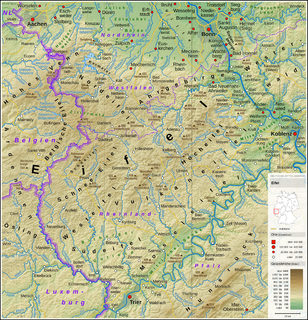
The Eifel is a low mountain range in western Germany and eastern Belgium. It occupies parts of southwestern North Rhine-Westphalia, northwestern Rhineland-Palatinate and the southern area of the German-speaking Community of Belgium.
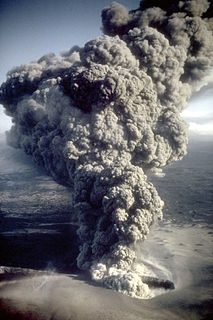
A maar is a broad, low-relief volcanic crater caused by a phreatomagmatic eruption. A maar characteristically fills with water to form a relatively shallow crater lake which may also be called a maar. The name comes from a Moselle Franconian dialect word used for the circular lakes of the Daun area of Germany.

Ahr is a river in Germany, a left tributary of the Rhine. Its source is at an elevation of approximately 470 metres (1,540 ft) above sea level in Blankenheim in the Eifel, in the cellar of a timber-frame house near the castle of Blankenheim. After 18 kilometres (11 mi) it crosses from North Rhine-Westphalia into Rhineland-Palatinate.

Meerfeld is a village and municipality belonging to a collective municipality in the county of Bernkastel-Wittlich in Rhineland-Palatinate, Germany.

The Volcanic Eifel or Vulkan Eifel is a region in the Eifel Mountains in Germany that is defined to a large extent by its volcanic geological history. Characteristic of this volcanic field are its typical explosion crater lakes or maars, and numerous other signs of volcanic activity such as volcanic tuffs, lava streams and volcanic craters like the Laacher See. The Volcanic Eifel is still volcanically active today. One sign of this activity is the escaping gases in the Laacher See.

The Hohe Acht is the highest mountain in the Eifel mountains of Germany. It is located on the boundary between the districts of Ahrweiler and Mayen-Koblenz in Rhineland-Palatinate.

The Weinfelder Maar, also called the Totenmaar, is a maar around two kilometres southeast of the town of Daun in the Eifel Mountains, in the German state of Rhineland-Palatinate.
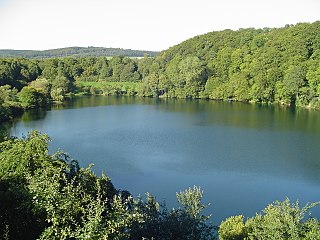
The Ulmener Maar is a maar in the Eifel mountains of Germany in the immediate vicinity of the town of Ulmen in the state of Rhineland-Palatinate. The lake is up to 37 metres deep and is surrounded by an embankment of tuff with an average height of 20 metres, which was formed from the erupted material of the former volcano. By the southern edge of the embankment are the ruins of a knight's castle, Ulmen Castle dating to the 11th century.

The Booser Doppelmaar comprises two maars that have silted up and, today, form shallow depressions in the countryside. They lie on the territory of the village of Boos, a few hundred metres west of the village itself. The two maars were formed 10,150 to 14,160 years ago and belong to the Quaternary volcano field of the Volcanic Eifel. From a natural region perspective it lies in the south of the Hohe Acht Upland, ca. 7.8 km south of the summit of the Hohe Acht.
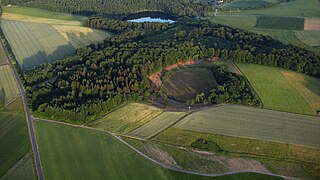
The Dürres Maar is a maar located in the vicinity of the village of Gillenfeld, Germany in the West Eifel mountains about 400 metres northwest of the Holzmaar. The Dürres Maar ist a dry maar, the original maar lake has silted up. It is surrounded by an embankment of lapilli-tuff which has only been gently eroded and has a diameter of about 290 metres. The Dürres Maar was formed more than 25,000 years ago.

The Pulvermaar is a water-filled maar that lies southeast of Daun in the German state of Rhineland-Palatinate. Together with the Holzmaar it is one of the Gillenfeld maars.

The Holzmaar lies in the Volcanic Eifel in the German state of Rhineland-Palatinate almost halfway between Gillenfeld and Eckfeld. The maar has an area of about 6.8 hectares, a diameter of 325 metres (1,066 ft) and a depth of 21 metres (69 ft) and lies within a nature reserve, almost completely surrounded by woods. It is one of the two maars making up the Gillenfeld Maars, the other being the Pulvermaar.

The Gemündener Maar is the northernmost of the three Daun Maars. It lies in the immediate vicinity of the village of Gemünden and ca. 1.5 km south of Daun in the Eifel and in the German state of Rhineland-Palatinate.

The Schalkenmehrener Maar is a maar roughly 3 kilometres southeast of the town of Daun in the Eifel in the German state of Rhineland-Palatinate.

Windsborn Crater Lake is a water-filled volcanic crater in the Eifel mountains in Germany. It is located near Bettenfeld in the county of Bernkastel-Wittlich and in the state of Rhineland-Palatinate, and belongs to a group of four craters known as the Mosenberg Crater Row, named after the village of Mosenberg.

The Dreiser Weiher near Dreis-Brück in the vicinity of Daun in the German state of Rhineland-Palatinate is a tub-shaped maar in the Eifel mountains. It is up to 1,360 metres long and 1,160 metres wide. It is the second largest maar in the Eifel.
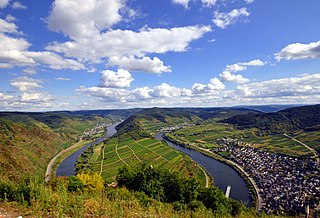
The Moselle Eifel forms the southeastern strip of the East Eifel to the left of the Moselle from the city of Trier downstream as far as Moselkern; in the southeast it does not reach as far as the Moselle Valley. It lies exclusively within the German state of Rhineland-Palatinate and is a truncated highland, roughly half of which is forested.
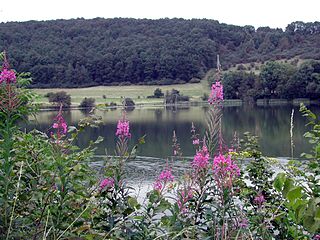
The Immerather Maar is a maar in the municipality of Immerath in the county of Vulkaneifel in the German state of Rhineland-Palatinate. It is part of a designated nature reserve and Special Area of Conservation.

The Mosbrucher Weiher, also called the Mosbrucher Maar, is a silted up maar east of the municipal boundary of the village of Mosbruch in the county Vulkaneifel in Germany. It is located immediately at the foot of the 675-metre-high Hochkelberg, a former volcano. The floor of the maar is in the shape of an elongated oval and is about 700×500 metres in size, its upper boundary has a diameter of about 1,300 × 1,050 metres. This makes the Mosbrucher Maar the third largest of the maars in the western Eifel region. The Üßbach stream flows past and close to the Mosbrucher Weiher.

The Rockeskyller Kopf near Rockeskyll in the county of Vulkaneifel in the German state of Rhineland-Palatinate is a hill, 554.6 m above sea level (NHN), in the Eifel mountains. It is an extinct volcano complex from the Quaternary period, around 360,000 years old and is designated as a natural monument (ND-7233-420).
| Wikimedia Commons has media related to Meerfelder Maar . |